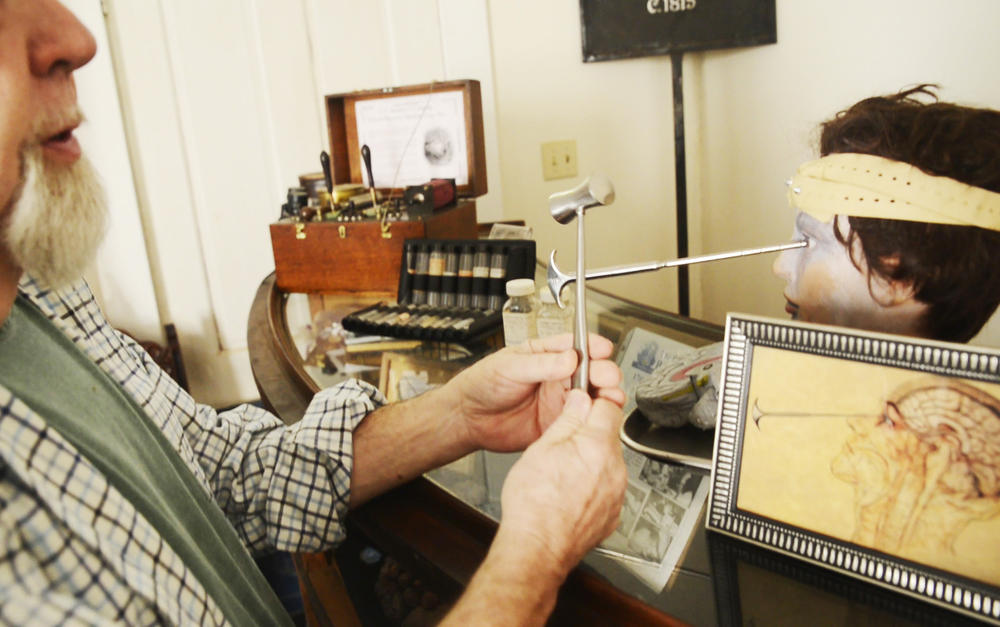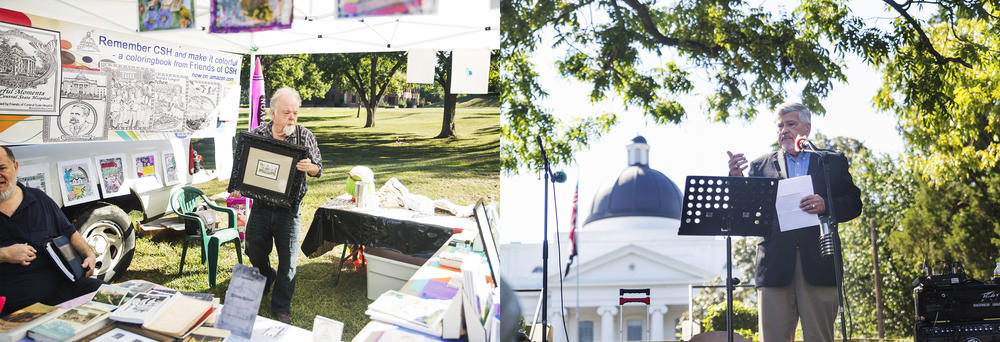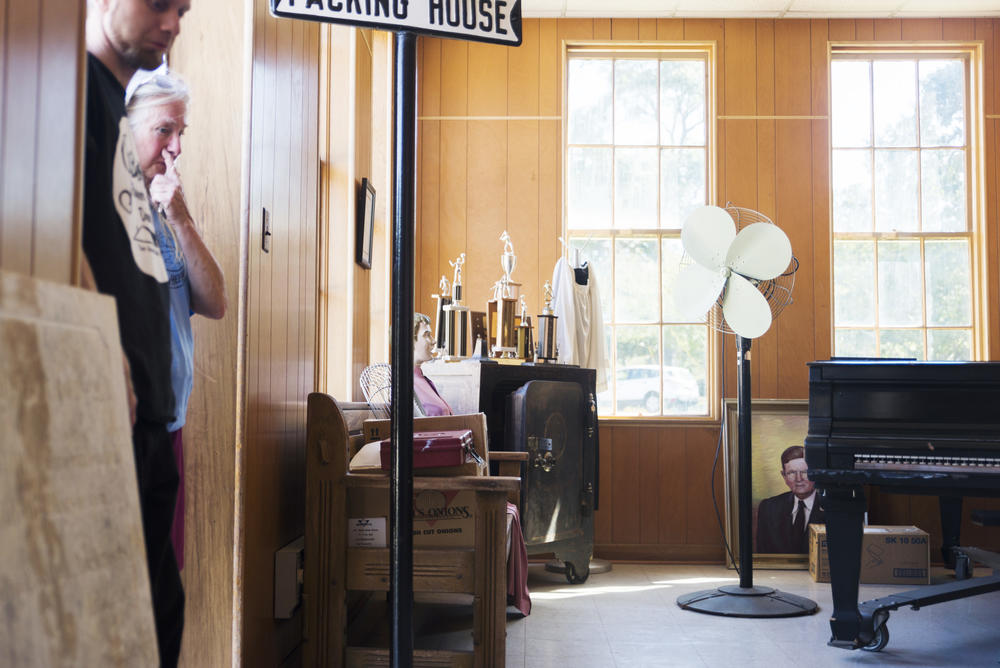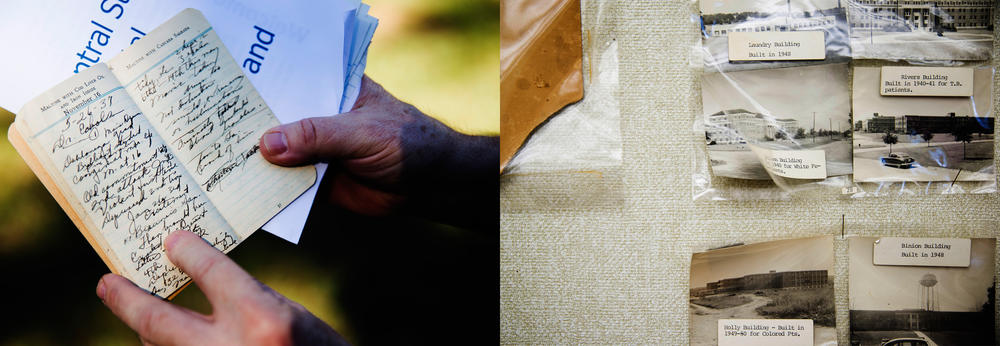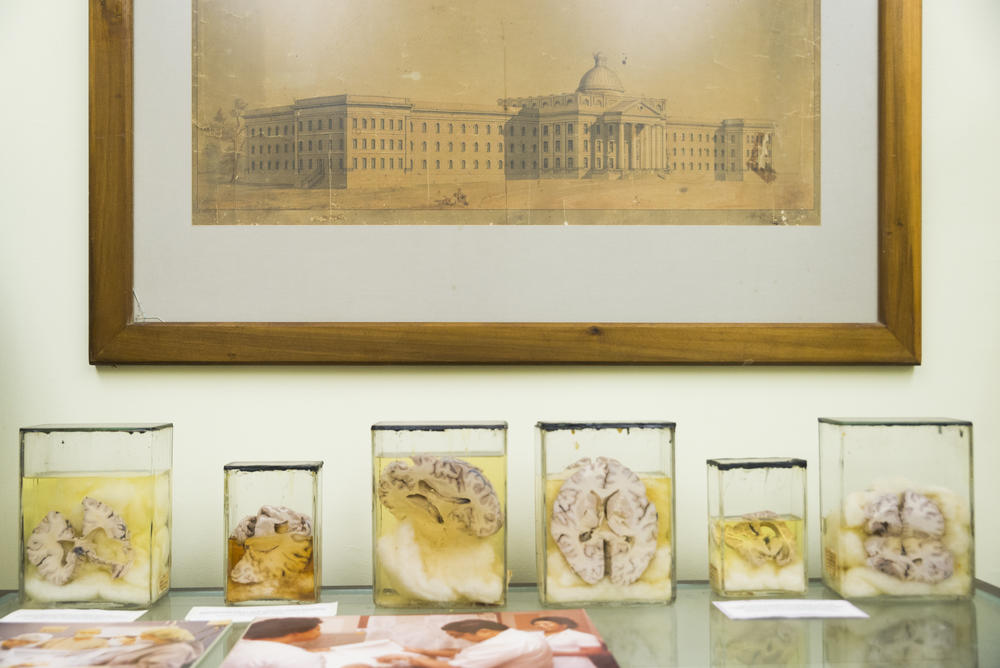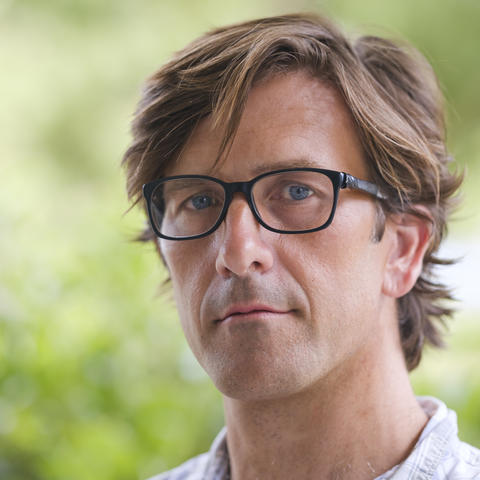Section Branding
Header Content
What's Next For An Old Asylum? Jobs Or History?
Primary Content
What's Next For An Old Asylum?
Barbeque smoke was in the air and a country band was belting out “Wagon Wheel” when Margreta and Bill Smith set foot in the pecan orchard at Central State Hospital in Milledgeville for the first time in over 20 years.
The Smiths met and married in the 1950s when both of them were among the thousands of people employed at this legendary psychiatric hospital. Margreta was a nurse and Bill was an attendant. An employee reunion picnic within sight of the iconic, white domed Powell Building is what brought them back.
“When we came here, it was the second largest mental institution in the world,” Margreta said. “We had 12,000 patients on the grounds and they had a safe place, which is the meaning of the word asylum.”
Central State was as much a small town then as it was an asylum. The 12,000 patients were served by their own farm and a 100,000 square foot kitchen that churned out 90,000 meals a day. In the days before sedation from psychiatric drugs, patients often just walked the grounds. Bill Smith says working here wasn’t always easy.
“You had to have something to rejuvenate your brain after you left here everyday. I mean you looking at crazy people 12 hours a day,” he said.
“You say mentally ill now. He's not always politically correct,” Margreta said with a laugh.
The Smiths say they would like to see Central State become a safe place for the mentally ill again but those days are gone. A shift in federal policy toward community based mental health care that began in the late 1990s means that won’t happen. Today the thousands of jobs that supported generations are sorely missed. According to the US Census Bureau, Milledgeville has a poverty rate of 46 percent. The state rate is 17 percent.
What’s left is the vast infrastructure of Central State Hospital. Some people see it as 150 years of mental health history while others, like Mike Couch, see ground zero for job growth.
Couch heads up the Central State Hospital Redevelopment Authority which put on the reunion picnic. He also grew up here.
“My mom was director of nursing,” he said. “I grew up playing in the pecan orchard.”
Couch left Milledgeville, was a career military officer and then as a civilian worked redeveloping shuttered military bases for the Department of Defense. He came home to sell Central State.
“We're left with real estate. I'm a real estate guy. So I'm looking at it from a real estate perspective,” he said.
He has a staff of one and a board of notable locals to help him sell the 2,000 acres here piece by piece. They are making progress. A Youth Challenge Academy, a sort of residential Outward Bound experience for at-risk kids, will bring 200 jobs to Central State. A nursing home for male parolees from the federal prison system on the site of the old Bostick Prison will bring more.
“We helped get that building demolished for a $19 million, brand new facility. That's 330 jobs,” Couch said.
Couch said if other old buildings at Central State are in the way of jobs, they may have to go, too.
“Now would it have been better to preserve that building? It was a shell of itself,” he said. “Our charter as the development authority, we're job creators. That's it.”
Even so, Couch said history does have its place.
“Let's not hide from it. Let's acknowledge it,” he said.
There is something like a museum at Central State, though it isn’t open to the public and it has no staff. It’s run by Georgia’s Department of Behavioral Health and Developmental Disability. Volunteers from Milledgeville’s Old Capital Museum helped the agency’s Rick Valentine open up just for the picnic.
“This room right here....” Valentine said pointing to corner set of drawers filled with surgical tools. “Nobody opens anything. Ask them to leave if they do.”
When a volunteer tried to place her purse just on the other side of a roped off doorway, other volunteers jokingly tried to oust her. They were set to open at noon but had a crowd at the door maybe twenty minutes before. They were Donna McNair’s special education teachers in training from nearby Georgia College and State University.
Once inside the museum, McNair and her students shuffled past a hodgepodge of painted portraits of hospital officials, athletic trophies, street signs, historic photos, even a program for a patient produced opera before they came to half a dozen brains in glass. Valentine explained.
“They would take out the part of your brain that controlled your emotions....,” he said.
Outside the museum, McNair explained why she brought her students.
“We know we still have work to do. We know we still have a long way to go,” she said. “But it makes us appreciate how far we've already come in our society accepting people with disabilities.”
That’s Edwin Atkins’ point.
Atkins is retired from the film industry where he was a location manager for movies like “The World According to Garp” and “A Clear and Present Danger.” He’s relatively new to Milledgeville, but has deep family roots here. His great-grandmother was a patient at Central State for 40 years, placed there by a husband frustrated by her habit of giving birth to daughters.
Atkins started the Friends of Central State group on Facebook in reaction to what he saw as the imminent danger posed by redevelopment to Central State’s history. The group has 7,000 members who share old photos, vent frustration at being locked out of hospital archives and just generally reminisce.
Atkins' home belonged to one of Central State’s founders, Tomlinson Fort. There he collects hospital artifacts, but don’t call it a museum. Not yet, anyway. There’s a psychiatrist’s diary, a straight jacket, a nurse’s uniform that belonged to Mike Couch’s mother, even lobotomy tools. He can demonstrate the last on a dummy’s head.
“With the patient alive and the eye socket pulled out they would tap this into the appropriate spot in the brain,” he explained.
This was mainstream psychiatry before anti-depressant and anti-psychotic drugs. A doctor associated with the procedure even won a Nobel Prize in 1949. Three years later the first anti-schizophrenic drug was introduced and the procedure began to fall out of common practice.
Atkins says the old buildings Mike Couch says are in the way of jobs have historic value. His ideas for what to do with them are unorthodox to say the least, like turning the place into a living mental health theme park.
“Where you can pick up pecans with people dressed like patients,” he added.
Or how about using the place as a movie studio for Georgia’s burgeoning film industry? It’s apparently really hard to find an asylum or old prison to film in. What he really wants, though, is a 2,000 acre museum of mental health, lobotomies and shock therapies included.
“The deplorable things that people would see in a museum at Central State is really the gateway to the enlightenment of the subject matter,” he said.
As nice as that sounds, Lauren Abis, Communications Director for the Redevelopment Authority, said Milledgeville can’t afford it.
“When we have 500 families in this community who can put food on their table and buy clothes for their kids for school, that's a lot more romantic to me than using the entire campus to honor the history,” she said.
Atkins acknowledged the need for jobs and said that there is more to this history than buildings and objects.
“You've still got plenty of oral history available. It hasn't all it not died off yet,” he said.
As it turns out, students from Georgia College and State University recorded oral histories with old employees at the reunion picnic. However, none of them will be published without the approval of Georgia’s Department of Behavioral Health and Developmental Disabilities, or DBHDD. Lauren Abis is the communications director at the Redevelopment Authority. She said the relationship between DBHDD and the Redevelopment Authority is a tricky one.
“They really like to make sure the content is controlled. So in an effort to not muddy the water or make the relationship less good we’re doing what they asked,” she said.
Part of the history DBHDD is left with is a 2009 finding by the US Department of Justice that all of Georgia’s mental hospitals violated patients’ civil rights. Stories, even legends, of what some might consider disturbing practices still dog Central State.
“I think [DBHDD] is just kind of tired of the conversation because it’s been going on for 50 years,” Abis said.
Abis said people might hate her for saying it, but right now the conversation at Central State Hospital should be about living people and not the past.
